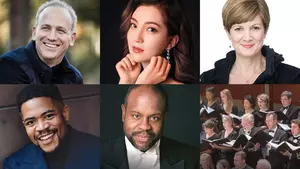“Welcome to the North Carolina Symphony!” chimed ushers as concertgoers filed into the Duke Energy Center for the Performing Arts. Friday evening, the North Carolina Symphony joined with the North Carolina Master Chorale to perform W. A. Mozart’s seminal Requiem in D minor, K. 626 to a receptive and full audience. Though the Requiem could stand alone in concert, the NC Symphony opened the program with Jean Sibelius’s Symphony No. 7 in C, Op. 105, the final symphony by the Finnish composer. As stated by conductor Carlos Miguel Prieto, these two pieces were representations of what “great minds can do towards the end of their lives,” and the concert invoked themes of humanity.
Written exactly 100 years ago, Sibelius’s 7th Symphony is a through-composed work in three distinct, uninterrupted sections; Maestro Prieto commented that the work was an example of how a composer can take something great and make it brief, saying, “Sibelius wrote a full symphony that takes just twenty minutes.” While the work may not be as long as others in the genre, the emotional depth and compositional prowess remain on par with works triple in length. The orchestra performed contrasts with great care in phrasing and dynamics, and I was particularly impressed with how seamlessly the sections of the ensemble were able to layer entrances. The string section built itself on the tone established by the bassi and celli syncopation to create a cohesive, if not gut-wrenchingly beautiful, wash of sound, and the wind and brass entrances bloomed out of each preexisting timbre so well that at one point I couldn’t tell if the violas were still playing as the horns started. Sibelius is known for his orchestration, and the ensemble displayed great understanding for how each individual melodic fragment comes together. Harmonic intrigue in the lyrical introduction was emphasized with warm vibrato, and the ensemble matched articulation with clarity as the piece transitioned into a scherzo-like middle section, especially in the second violins who provided a motor of continuous eighth notes underneath brass chorales. Prieto’s conducting aided greatly in the emotional transitions of the work, and he used his left hand to fluidly spin phrases while maintaining clarity with his right hand during more intricate moments of counterpoint; the effect created an ensemble with momentum, both rising and falling as the piece transitioned between fast and slow thematic material. The final cadence felt like a sigh of contentment and the couple in front of me shared a loving glance as the piece resolved.
After intermission, a reduced symphony returned to the stage along with the formidable North Carolina Master Chorale. After so long without community music-making, it was remarkable to see so many people together on one stage with the collective mindset to create something beautiful together. Mozart’s Requiem is a setting of the Catholic Latin Mass, and despite the composer’s untimely death, the Requiem was completed by Franz Xaver Süssmayr the following year. The work is divided into eight distinct sections (Introitus, Kyrie, Sequentia, Offertorium, Sanctus, Sequentia, Benedictus, Agnus Dei, and Communio), with smaller movements making up the first Sequentia and Offertorium. The audience was provided with detailed program notes, as well as the lyrics and their English translations; at first I was disappointed to see there wouldn’t be supertitles, but having the Latin and English text side-by-side in my lap proved to be a better experience, as I was able to follow the exact translations and hear when Mozart’s text painting changed upon repetition of a line. Moments of distress were contrasted with angelic pleas; marcato brass and timpani punctuated lyrics about the “flames of woe” and “pains of hell,” while sonorous violins and winds demonstrated requests for mercy and deliverance.
The Requiem features four vocal soloists throughout, and I was thoroughly impressed with their individual ability, as well as their ensemble; soprano Meigui Zhang, mezzo-soprano Susan Platts, tenor Terrence Chin-Loy, and bass Kevin Deas were able to oscillate between brilliant solos and sensitive accompaniments in truly operatic ways. Whenever the quartet sang together, the balance between each voice part was distinct without diminishing the uniqueness of each individual’s tone and affect; the choir and orchestra supported the soloists elegantly, taking care to match the shapes of phrases and articulations. During tutti moments, the choir was able to access the full range of dynamics, and the orchestra supported sensitively; the piece has a lot of fugue and counterpoint, and I commend the ensemble as a whole for maintaining clarity upon each entrance, despite the dense nature of the composition. Each vocal line had a corresponding section in the orchestra, and as an instrumentalist I felt as though the doubling of melodies between symphony and the choir helped not only the ensemble, but the audience, keep track of the melodic themes–I’ve had the privilege to play several requiems, but being on the other side of the stage provided a great perspective on how something so intricate up close can be so cohesive from afar.
Upon the final chord, the audience immediately provided a standing ovation as the conductor acknowledged the soloists and each section of the orchestra individually. The program demonstrated both the tenacity and humility of humanity, and the universal nature of the human experience. I thoroughly applaud the North Carolina Symphony and North Carolina Master Chorale for such a meaningful and well-executed performance.












